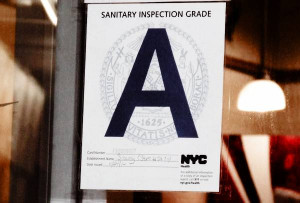It’s deeply weird or deeply hypocritical that Seattle, self-proclaimed home to many things food, doesn’t have a decent restaurant inspection disclosure system.
 “We’ve tried to make as much information available as possible,” says Becky Elias, Manager of Food Protection for Public Health – Seattle & King County. “As a consumer, you could look up an individual restaurant and see the entirety of all of their inspections, and see how they’ve done. We did that because we wanted it to be as transparent as possible.”
“We’ve tried to make as much information available as possible,” says Becky Elias, Manager of Food Protection for Public Health – Seattle & King County. “As a consumer, you could look up an individual restaurant and see the entirety of all of their inspections, and see how they’ve done. We did that because we wanted it to be as transparent as possible.”
But two-time E. coli victim Sarah Schacht says the system is antiquated and overly complicated, making it difficult to quickly determine how a restaurant is actually doing.
She launched a petition on Change.org earlier this year calling for the county to mandate publicly posted restaurant inspection scores. She says other cities such as Los Angeles, San Francisco and New York have seen significant reductions in food-related illnesses since restaurants began posting A, B, C, or F grades in their front window.
“We saw, in Toronto, a 30 percent reduction of total foodborne illnesses when they started a public scoring system for restaurants,” Schaht says.
“We have heard that message loud and clear that that’s something people are wanting,” Elias responds. “So we’re now actively engaging in the process.”
The health department has formed several committees made up of restaurants, health officials and others to come up with new policies for presenting food inspection results.
Elias says they’ll look at findings from other cities, and while they might not adopt a letter grade, they are committed to some public display that quickly informs customers how a restaurant fared.
 “I think that we’re really excited about working towards something that meets the need of improving food safety, making something that is easier for people to understand, and also designing something that is equitable for the incredibly diverse array of food businesses that we have here in King County,” says Elias.
“I think that we’re really excited about working towards something that meets the need of improving food safety, making something that is easier for people to understand, and also designing something that is equitable for the incredibly diverse array of food businesses that we have here in King County,” says Elias.
I’m glad you’re excited, with your public service salary, but you haven’t done anything. Toronto did it 12 years ago.
Here’s some researxh to get you more excited.
Can I have your salary and benefits?
Filion, K. and Powell, D.A. 2009.
The use of restaurant inspection disclosure systems as a means of communicating food safety information.
Journal of Foodservice 20: 287-297.
Abstract
The World Health Organization estimates that up to 30% of individuals in developed countries become ill from food or water each year. Up to 70% of these illnesses are estimated to be linked to food prepared at foodservice establishments. Consumer confidence in the safety of food prepared in restaurants is fragile, varying significantly from year to year, with many consumers attributing foodborne illness to foodservice. One of the key drivers of restaurant choice is consumer perception of the hygiene of a restaurant. Restaurant hygiene information is something consumers desire, and when available, may use to make dining decisions.
Filion, K. and Powell, D.A. 2011. Designing a national restaurant inspection disclosure system for New Zealand. Journal of Food Protection 74(11): 1869-1874 .
The World Health Organization estimates that up to 30% of individuals in developed countries become ill from contaminated food or water each year, and up to 70% of these illnesses are estimated to be linked to food service facilities. The aim of restaurant inspections is to reduce foodborne outbreaks and enhance consumer confidence in food service. Inspection disclosure systems have been developed as tools for consumers and incentives for food service operators. Disclosure systems are common in developed countries but are inconsistently used, possibly because previous research has not determined the best format for disclosing inspection results. This study was conducted to develop a consistent, compelling, and trusted inspection disclosure system for New Zealand. Existing international and national disclosure systems were evaluated. Two cards, a letter grade (A, B, C, or F) and a gauge (speedometer style), were designed to represent a restaurant’s inspection result and were provided to 371 premises in six districts for 3 months. Operators (n = 269) and consumers (n = 991) were interviewed to determine which card design best communicated inspection results. Less than half of the consumers noticed cards before entering the premises; these data indicated that the letter attracted more initial attention (78%) than the gauge (45%). Fifty-eight percent (38) of the operators with the gauge preferred the letter; and 79% (47) of the operators with letter preferred the letter. Eighty-eight percent (133) of the consumers in gauge districts preferred the letter, and 72% (161) of those in letter districts preferring the letter. Based on these data, the letter method was recommended for a national disclosure system for New Zealand.
